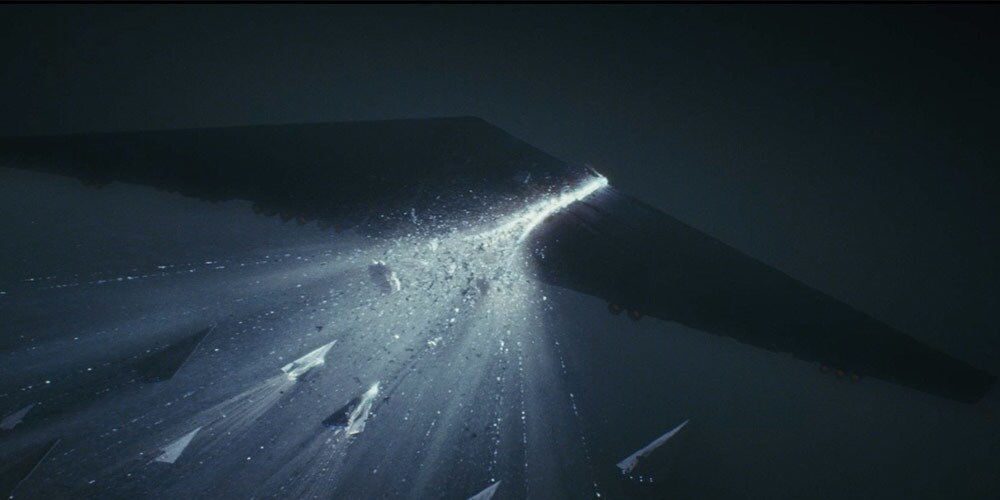Uncovering the mysteries of sound in Star Wars: The Last Jedi.
The unmistakable genius of John Williams' soundtrack plunges us into Star Wars: The Last Jedi, like every saga film before it, but the emotional pull that keeps us connected goes far beyond the musical score and iconic sound effects of clashing sabers and Wookiee roars.
ABC News Features recently pulled back the curtain on the dedicated team at Skywalker Sound for an in-depth look at the subtle nuances and surprisingly normal tools that blend together to enrich the Star Wars galaxy. (There are spoilers ahead in both the video and our breakdown, so proceed with caution.) It's sound that gives each digital character weight and personality, making everything from the tiniest gestures to the big climactic moments feel authentic. Behind the scenes, there's a team of audio experts at work to find the perfect noise to evoke emotion or heighten drama through an extensively layered mix or, sometimes, the complete absence of sound.
Here are five fascinating things we learned from "The Force of Sound: Creating sounds in galaxy far, far away" (which you can watch here).
1. In the recording booth, BB-8 doesn't look at all like you might think.
To create the illusion that the spherical astromech is rolling through each scene, the sound effects team in the studio rolls a granite orb on a special box. It's just one example in a vast arsenal of strange props and tools that help audio engineers and sound designers capture the magic of a galaxy far, far away. “It's like an old radio play,” says Matthew Wood, supervising sound editor. The team relies on everything from recordings of live birds and other natural sounds, to more pedestrian items like coins, gloves, garlic presses, and mysterious metal instruments. “The moves may be very small, but we do all of them,” says longtime foley artist Margie O'Malley. And a familiar sound can tether an alien creature to our own reality in a way that makes Star Wars feel completely authentic. “Because you can't see it, you hear it and that is a pure feeling,” says Wood.
2. The porg sound was one of the first elements tackled for the film.
Ahch-To's resident space puffins provided one of the first challenges for sound designer Ren Klyce and his team, in part because of the demands of the toy manufacturing schedule, which runs concurrent to production. Director Rian Johnson's notes on the matter? “Birdlike. Kind of annoying but not too annoying.” Real bird sounds, sped up and played at a higher pitch, and one intern's turkey call helped to create the perfect trilling squawk to complement the wide-eyed creatures and their innocent on-screen demeanor.
3. The art of sound mixing relies upon layers of sound to enrich the environment.
If you've never really noticed each fathier hoofbeat or rattling lightsaber hilt, that's OK. “If your work's invisible, that means that you're doing your job properly and that it's actually working,” says Klyce. Most of the time, the final piece is a delicate tapestry that includes music, vocals, background noise, and each corresponding tone — the “sound glue” — that makes the action onscreen feel real. When the mix is complete, it can evoke feeling, life and drama. “It's magical. It's amazing,” says Johnson. “Sound is still such a mystery to people, to the point where it's not even something you think about there being an involved process behind.” At times, multiple recordings of the same noise may be added together to add depth. “Sometimes we add two sounds, when one burp isn't enough,” says Klyce.
4. Sometimes it's the absence of sound that makes the moment come alive...
There's a moment just after the Holdo maneuver where the sound vanishes, replaced by utter silence. “The film's so bombastic with noise that at the largest moment when Snoke's ship is being destroyed by Holdo doing her kamikaze/seppuku run into it...to have then an explosion there just would have been fine,” says Klyce. “The idea to have nothing there was more interesting and to kind of make everybody wait for it.”
5. ...or hints at a deeper connection to the Force.
Sound designers went through trial and error to help Johnson convey his vision for the most vulnerable moments of Force connection between Kylo Ren and Rey. “(Sound) can expand something to make it feel bigger than it is, it can make you feel small and intimate if you've pared everything away and taken out sound and left a little vacuum,” says Wood.
And when they approached the final battle between Luke Skywalker and his nephew, audio and visual clues hinted that the Jedi Master wasn't physically on Crait long before the big reveal. Listen closely and you can hear debris sizzling on Kylo's saber. When the camera pans to Luke, there's nothing, not even the sound of his footfalls. “We tried to juxtapose that so you're getting clues,” Wood says.
Star Wars: The Last Jedi arrives on Digital and via Movies Anywhere on March 13, and on 4K Ultra HD, Blu-ray, and On-Demand on March 27.
Watch "The Force of Sound" now.
Kristin Baver is a writer and all-around sci-fi nerd who always has just one more question in an inexhaustible list of curiosities. Sometimes she blurts out “It’s a trap!” even when it’s not. Do you know a fan who’s most impressive? Hop on Twitter and tell @KristinBaver all about them!






